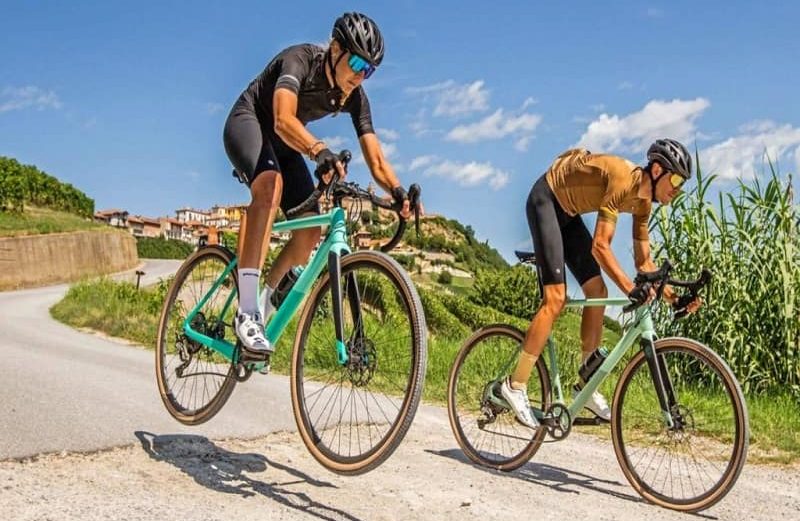From the outset, it tends to be difficult to differentiate between a Cyclocross Vs Gravel Bike. Both offer drop handlebars, knobbly tires, unbending edges (as a rule), and more extensive tire clearances than their street-going reciprocals. So what are the distinctions?
Here, we break down the vital contrasts between Cyclocross Vs Gravel Bike, see what they’re explicitly intended for, and consider which may be best for yourself as well as your rough terrain pursuits. We’ve likewise got a different aide – street bicycle versus rock bicycle – on the off chance that you’re attempting to choose the street speed and rough terrain flexibility.
Dissimilar to Cyclocross Vs Gravel Bikes are commonly intended for a scope of purposes, from multi-day biking backpacking undertakings to multi-territory investigating nearer to home, and, surprisingly, the prospering rock hustling scene. Subsequently, rock riding is a broad discipline and, with rock bicycles utilized for a wide assortment of riding, they will generally be less uniform in plan than cyclocross bicycles, albeit the best rock bicycles share a few key highlights.
Before rock bicycles showed up on the scene, and with the coming of street circle slows down, some bicycle brands offered a cyclocross bicycle with some additional flexibility tossed in the blend, including curved guard and rack mounts. Notwithstanding, with the beginning of rock bicycles and the inborn adaptability they offer, a significant number of the most recent cyclocross bicycles have become refocussed on CX hustling.
Right, that is the nuts and bolts covered, presently we should investigate the critical contrasts between Cyclocross Vs Gravel Bike, including math, tires and tire leeway, mounts, and completing unit from there, the sky is the limit.
Table of Contents
You Might Also Like ⇒
- Best Road Bikes Under 300
- Best Road Bikes Under 500
- Best Road Bikes Under 1500
- Best Entry Level Road Bike
- Best RoadMaster Bike
- BEST FAT BIKES
- Best Fat Bikes Under 1000
- Best Mountain Bikes Under 1000
- BEST ELECTRIC BIKE UNDER 1000
- BEST FOLDING MOUNTAIN BIKES
- Best Beginner Road Bike
- Best Fat Bikes Under 2000
THE TOP 6 DIFFERENCES BETWEEN
A CYCLOCROSS VS GRAVEL BIKE IN 2022:

With more enthusiastic street cyclists, long-distance runners, and even mountain bikers finding the delights of rough terrain riding on a drop-bar bicycle than at any other time, it’s essential to comprehend the critical contrasts between the two most well-known sorts of double reason machines: cyclocross vs gravel bike. A decent, straightforward guideline to recall is that a cyclocross bicycle is undeniably appropriate for, as its name infers, going quick along a cyclocross racecourse.
While a rock bicycle is streamlined for the entire day riding experiences over a blended landscape. In any case, what precisely isolates these two sorts of bicycles as far as yielding different riding encounters? Also, mightn’t you at any point have one of the two sorts of bicycles to use for both rock riding and cyclocross dashing? Before we answer that subsequent inquiry, we should separate the main five critical contrasts between a gravel bike and a cyclocross bike.
1. GEOMETRY
The central contrast between a cyclocross bicycle and a rock bicycle is tracked down in their separate calculations. Cyclocross bicycles are intended to be hustled on cyclocross courses, which can frequently incorporate an assortment of landscapes like mud, sand, shakes, and even snow. They likewise incorporate run-up segments that expect racers to get off their bicycle, as well as obstructions that should be gotten around either by getting off or rabbit bouncing. In that capacity, a cyclocross bicycle will have a higher base section level compared with a rock bicycle, and, surprisingly, a street bicycle.
A cyclocross bicycle will likewise have more limited chainstays and a lower stack level, the two of which join for a more forceful riding position and fundamentally more deft dealing with than a rock bicycle. This is purposeful by the plan because the bounds of a cyclocross racecourse are extraordinarily close, expecting racers to dial back quickly, roll through a difficult manoeuvre, and afterwards speed up to speed rapidly — a cycle which is rehashed endlessly all through different laps of a race.
Riding on open rock streets, or even a combination of cleared and rough terrain surfaces, by correlation, normally does exclude such monotonous, sharp corners and speedy speed increases. Nor does this sort of riding require the rider to get off their bicycle. However, it incorporates an undeniably more significant length of street that will have the rider going at higher velocities for longer terms.
Thusly, a rock bicycle will be considerably more steady than a cyclocross bicycle, on account of its more drawn-out wheelbase, longer chainstays, and lower base section level. Furthermore, once more, since rock bicycles are by and large intended for flexibility and solace throughout the entire day riding experience, a rock bicycle will for the most part have a taller stack level to consider a more upstanding riding position.
2. CAPACITY SOLUTIONS
A cyclocross race regularly endures somewhere in the range of 30 and an hour and a half and is ridden at extremely focused energy. So there’s no requirement for the rider to convey the provisions that one would commonly take on a street ride or rock ride. These incorporate things like a punctured tire fix unit, nourishment items, and unnecessary hydration. So a cyclocross bicycle will shun capacity includes that oblige these things chasing a lighter frame and added speed.
Everything revolves around that platform position! Paradoxically, a rock bicycle will highlight a lot of capacity answers for permit its rider to convey sustenance, hydration, devices, spare cylinders, and whatever else the rider will require throughout a drawn-out day in the seat — particularly on the off chance that they wind up off in an unexpected direction. In like manner, rock bicycles will frequently highlight mounts for racks and bumpers, to give them some additional adaptability for driving and wet-weather conditions riding.
3. OUTFITTING
As we’ve illustrated in the past segment, a cyclocross race is a moderately short, yet stunningly extreme, exertion. Outfitting necessities can change extraordinarily contingent upon the particular racecourse, yet overall, a cyclocross bicycle doesn’t need the scope of cogwheels that a rock bicycle, or even a street bicycle, commonly does. The most well-known design arrangement for a cyclocross race bicycle is a 46/36 chainring blend matched with an 11-36 tape, or something almost identical.
This guarantees that during the extreme focus exertion of hustling, bounces between gears are kept to a base to guarantee smooth and exact moving, all while permitting the rider to keep their accelerating rhythm and power steady. A 46-tooth chainring may appear to be little at first to experienced street cyclists, however, remember that the top-end paces of the cyclocross racecourse don’t arrive at those of a common street or gravel bike.
With regards to rock riding, the world is your jungle gym, as you’re not restricted to the region between the limit tape at a cyclocross racecourse. This implies you can experience any sort of geology, and incorporate short, punchy moves, as well as lengthy twisted climbs, very much like you, ‘d find while out for a ride on a street bicycle. Likewise, you’ll undoubtedly be heading out the street on hard-stuffed soil, free sand, and in the middle between.
That is the reason rock bicycles regularly have wide-range equipping, to ensure that you’re ready to vanquish any trip, however, have a lot of energy for a long plummet back home or a cordial yet serious run with your pals. For 1x drivetrains (that is, bicycles with a solitary chainring), hope to see a chainring with 38 to 42 teeth, alongside a tape with an 11-42 spread, or something almost identical. For 2x drivetrains, famous chainrings blends for rock bicycles incorporate 50/34 and 48/32, and they’re generally matched with 11-34 or comparable tapes.
4. WHEEL AND TIRE SIZES
The accepted wheel size for cyclocross bicycles is 700c, which is equivalent to by far most street bicycles. Some bicycle organizations offer bicycles with the more modest 650c wheel size to oblige more modest riders, however, this training has consistently been outgrowing design as most organizations have had the option to modernize the calculations of their bicycles to permit all riders to use 700c wheels. For cyclocross races that are authorized by the UCI, the game’s overall overseeing body, bicycles should be fitted with tires no more extensive than 33mm.
Notwithstanding, it’s significant that rules rotating around the size furthest reaches of your tires will differ by nation or league with regards to non-UCI authorized occasions. The greater part of your nearby occasions probably won’t be UCI-endorsed, so we firmly prescribe checking with your dashing association to figure out what their standards are with regards to tire sizes. No matter what the assortment of precludes there for various districts, most bicycle makers have upgraded the presentation of their cyclocross bicycles around the 33mm norm. This implies that most cyclocross casings will just acknowledge up to a size 33mm tire.
Since rock riding is about the investigation, having some good times, and pursuing the nightfall across a wide range of landscapes possible, most rock bicycles have been planned around flexibility. Like cyclocross bicycles, the most widely recognized wheel size is 700c. However, some rock bicycles, similar to the Breed, were planned with double wheel similarity — this implies that they can move on either a 700c wheel or a 650b wheel.
This implies that getting a bicycle like the Breed is truly similar to getting two bicycles in one! With regards to 700c wheels, there’s normally freedom for tires up to around 42mm or somewhere in the vicinity, while 650b wheels can use a lot more extensive tires because of their littlest peripheries, as a rule around 2.0 inches (which is normal on numerous hardtail trail blazing bicycles). The more extensive tires matched with 650b wheels make for more footing, particularly with regards to sloppy or rough landscapes.
5. SOLACE AND STIFFNESS
As we’ve previously noted, cyclocross races comprise somewhat short (30-to hour and a half) endeavours of focused energy with consistent hard slowing down into corners followed by prompt speed increases, lap after tiresome lap. Thusly, a cyclocross bicycle is by and large built with a stiffer undercarriage to boost the rider’s accelerating power to put every watt towards positive progress. All things considered, in a race, each second of time counts. In any case, this can likewise prompt a particularly solid bicycle.
While numerous riders incline toward a firm edge with a lot of input from the street or soil, others don’t. That is the reason most rock bicycles highlight more a solace situated development, which includes things like carbon layups and special cylinder shapes working as one to relieve the impacts of vibrations and successes from the soil, making for a happier riding experience throughout a long ride on the landing area, rock, soil, and every kind of surface.
Now that we’ve illustrated the five most tremendous contrasts between a rock bicycle and a cyclocross bicycle, we should return to one of our unique inquiries: Can’t you simply have one of the two kinds of bicycles to use for both rock riding and cyclocross dashing? The short response is, indeed, you can. Cyclists consistently draw out their cyclocross bicycle for their number one rock street ride, and, when necessary, a rock bicycle will work modestly enough on the cyclocross course to get you to the end goal.
However, as you’ve most likely gathered from the data above, cyclocross bicycles are unmistakably appropriate for cyclocross hustling, while rock bicycles are a considerably more flexible choice for different sorts of blended surface riding. On the off chance that you can have one, we suggest that you think about each of the sorts of riding you intend to do over the approaching season and gauge your needs appropriately. Regardless kind of bicycle you pick, we guarantee that you’ll have a good time getting ready to take care of business.
6. Gravel vs Cyclocross Finishing Kit
There are generally a few differences between cyclocross bikes and gravel bikes in terms of finishing kit.
UCI rules dictate that cyclocross handlebars can be no wider than 50cm, and generally, most bikes are fitted with bars significantly narrower than this, in proportion to the rider’s size.
Following the well-established trend towards wider mountain bike handlebars, there’s a growing trend towards super-wide gravel bike handlebars that sometimes exceed this 50cm limit, for riders who enjoy the wide, stable stance for more techy off-road trails.
The PNW Components Coast cockpit is just one example of this, with a 52cm option (measured at the hoods), giving a mega-wide measurement in the drops of 60cm.
While cyclocross bars tend to feature a traditional drop, flared bars are common on gravel bikes. These bars vary from a very subtle degree of flare to very steep angles, which means that the position in the drops is wider than on the hoods (as seen in the photo above), giving a more stable position for descending.
Frequently Asked Question(FAQ):
Q. Could I at any point utilize my cyclocross bicycle for rock riding?
The Cannondale SuperSix Evo SE, in rock hustling spec. Cannondale
In a word, yes.
While tire clearances might be your restricting element for fitting some chunkier elastic into your cyclocross outline, numerous riders do decide to adjust cyclocross bicycles for general heading out street.
At times, the calculation distinctions among rock and cyclocross models are minimal: for instance, the 2022 Cannondale SuperSix EVO outline is accessible in two forms, rock hustling (SE) and cyclocross (CX), and the new Specialized Crux has been rebranded as a rock dashing apparatus.
Post-retail parts, for example, erupted handlebars can be added to a cyclocross bicycle to further develop solidness over more unpleasant paths, and you can continuously adjust the outfitting on the off chance that you find you want a more extensive territory.
Q. Could I at any point utilize my rock bicycle for cyclocross hustling?
You’ll have the option to utilize a rock bicycle to race ‘cross by any stretch of the imagination however UCI races – sorry van der Poel, you’ll need to leave the Grail at home. DAVID STOCKMAN/Contributor
Except if you’re contending at a UCI-level race, generally speaking utilizing a rock bicycle for a cyclocross race will be totally fine, regardless of whether you’re running tires over 33cm or bars more extensive than 50cm.
Neighbourhood cyclocross associations are in many cases considered the most open type of cyclocross dashing, and everybody is urged to try it out on essentially any bicycle equipped for heading out street.
Try not to think you want to have a classification explicit bicycle to plunge your toe in – numerous riders get going on an off-road bicycle or comparative.
If you will utilize your rock bicycle for a cyclocross race, the main thing to consider will be the tires. On the off chance that you’re hustling in sloppy and wet circumstances, you might have to change out your tires for something with a more forceful track to provide you with a good degree of grasp in the slop.
The main thing, notwithstanding, is to stall out and have some good times!
SO CAN BOTH BIKES MAKE GOOD GRAVEL AND CYCLOCROSS BIKES?

Totally! Do you stringently require two distinct bicycles for drop-bar soil? No, however, it very well may be helpful assuming that you’re getting truly into either.
You can positively make variations to your bicycle to make it reasonable for both rock and cyclocross, even though that will rely upon what you’re now running.
It very well may be simpler, to begin with, a rock bicycle, as you can undoubtedly fit smaller tires, yet you can’t get included leeway a cyclocross bicycle where there isn’t any.
Assuming you’re hoping to purchase a solitary bicycle to do both, there are a couple of bicycles available that have this as a top priority, similar to the Ribble GCR (Cross, Gravel, Road).
CYCLOCROSS BIKES VS GRAVEL BIKES SUMMARY
Anyway, what are the critical contrasts between cyclocross versus rock bicycles?
Calculation – The cyclocross bicycle has a more forceful race position which brings about the rider being more loosened up. The rock bicycle, then again, highlights a somewhat more upstanding position. This makes them ideal for rides going from the fast drawn-out hike to the entire day or bikepacking stories.
Top cylinder – Our CX bicycles have an even top cylinder which makes them more straightforward to bear in CX races. The rock bicycles have a more slanted top cylinder which brings about a smaller math for more effective power moves.
Tire leeway – CX bicycles are confined by UCI guidelines to the most extreme freedom of 33mm. However our CX AL and CX SL outlines both proposition leeway for 38mm tires, the Gravel bicycles are viable with tires up to 47mm.
Link steering – All of the rock range is viable with electronic equipping. The CX SL carbon is likewise viable with electronic outfitting however the CX AL comes up short on the important link directing.
Equipping – overall CX races will generally include the less different territory. The truly steep stuff is as a general rule unrideable so cross racers don’t need a wide stuff range. Rock bicycles notwithstanding, need to adapt to limits of territory so a colossal stuff range is worthwhile.




